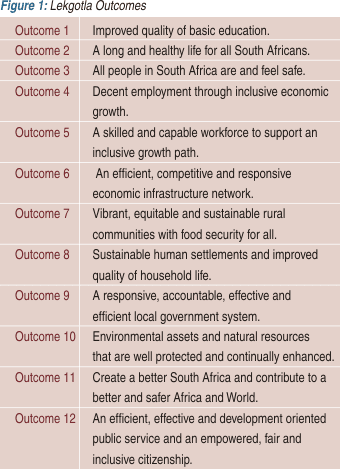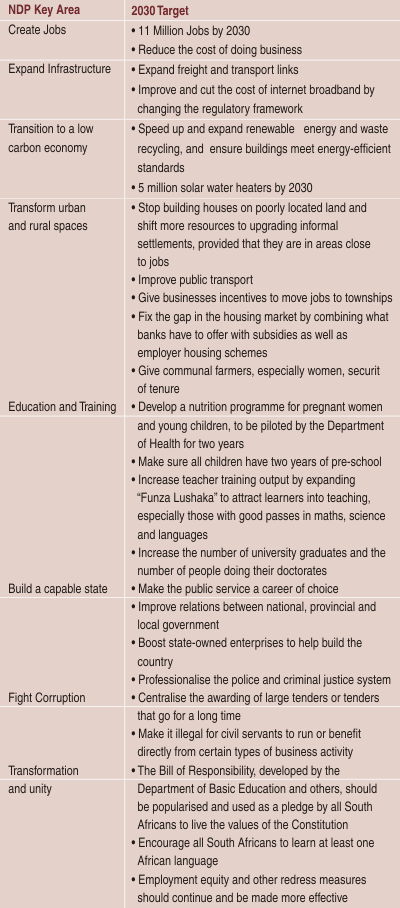|
3.1
The Context of GDS1?
November 2006, when GDS1 was adopted, was a time of optimism and positive economic growth. It was at a time of looking forward to the 2010 FIFA Soccer World Cup. The 2006 Local Government Elections heralded in new mandates and delivery goals. The concept of the GCR was being rolled out.
3.2
Changing World 2006 - 2011
Since that time, global, national and local events have placed a number of challenges and priorities into the Sedibeng setting. This section looks at some of the key issues that have influenced changes found in GDS2.
3.2.1 Global Events
a | A burgeoning World Population
By 2011 the population of the world tipped the 7 billion mark with rapid population growth predicted for the future. The effects of this on economic, ecological sustainability and overall quality of life will be felt by all of us in some way or another.
b | A Global Financial Downturn
The financial collapse that emerged in the late 2000 is considered by many economists to be the worst financial crisis since the Great Depression of the 1930s. It resulted in the collapse of large financial institutions, the bailout of banks by national governments, and downturns in stock markets around the world. It contributed to the failure of key businesses, declines in consumer wealth estimated in the trillions of U.S. dollars and a significant decline in economic activity, leading to a severe global economic recession by 2008. Recovery, although visibly happening, is still fragile.
South Africa, and even Sedibeng, has felt the pinch of the Global Credit Crunch. It felt it in a loss of appetite for investment into some of the large flagship projects, and in government's inability to keep the region's equitable share on par with rising costs of salaries and commodities. The District and Municipalities have felt it as more and more, as households struggle to pay for services.
c | Climate Change
Climate change and its harsh realities are felt across the globe, creating uncertainty and negatively impacting growth and development plans. In South Africa in November and December 2011, world leaders tried to once again check progress in implementing previous agreements such as the Bali Action Plan (COP 13) and the Cancun Agreements (COP 16) in a hope to fulfil the aims of the Kyoto Protocol adopted in 1997. These issues were on the table in 2006 when GDS 1 was adopted, but since then the ravages of Climate Change are becoming more and more obvious.
Sedibeng cannot be relegated to the position of observer in a changing world. Already the region is exploring several sources of alternative energy.There are several projects for the installation of solar geysers across the District. GDS2 encourages plans to be created for the acceleration of these projects. Sedibeng will need to explore the possibilities of deriving energy from the flow of the Vaal River and the creation of solar farms.
3.2.2 The National Context
a | Elections in South Africa
In 2009 South Africa held its fourth national election,and local government elections took place in 2011. The ruling party manifestos reaffirmed the need to:
- build local economies that create more jobs, decent work and sustainable livelihoods
- improve and expand local public services
- create more united, non-racial, integrated and safer communities
- promote more active community participation in local government
- ensure effective, accountable and clean local government, working together with provincial and national government
The manifesto commitments arise from a recognition that the inequality and divisions of apartheid persist and continue to pervade all aspects of our lives. The National Planning Commission (NPC), established by the president in May 2010, to propose a 20 year vision and plan for the country, notes that much still has to be done to create an equal society where all South Africans have fair access to basic services, education and economic prosperity.
b | Priorities of Government
The fourth democratic elections ushered in a new electoral mandate which defines the strategic objectives and targets of government for the period 2009 – 2014, outlined in the Medium Term Strategic Framework (MTSF) for 2009 to 2014. The strategic plan of the Presidency was developed in alignment and in response to the strategic agenda of government (MTSF), which set out twelve priorities that government will pursue in the five-year electoral period. These main priorities underpin the strategic direction of government.The Cabinet Lekgotla held from 20 to 22 January 2010 adopted the following 12 Outcomes:

c | The Local Government Turnaround Strategy (LGTS)
The purpose of the LGTS was to determine key problems in different areas and their root causes. From these assessments, the consolidated State of Local Government Report was compiled and consultations conducted with stakeholders. Subsequently, the LGTAS was developed. The aim of this country-wide programme is to mobilise government and society at large to deal with the factors undermining Local Government and to restore the community's confidence in the country's municipalities, while improving their performance. The strategy that was developed represents the views of a wide variety of stakeholders who participated in what was to become the most intensive consultative process ever undertaken on Local Government in this country.
d | The National Development Plan (NDP)
On the 11 November 2011, the National Planning Commission unveiled the blueprint for the development of our nation. The Plan seeks to eliminate poverty and reduce inequality. It seeks to ensure that citizens have the capabilities to grasp the ever broadening opportunities available. It plans to change the lives of millions of South Africans especially the youth. GDS2 aligns itself to the National 2030 Plan. GDS 2 must take the key elements of the NDP and give them local meaning in Sedibeng. The table below summarizes the key elements of the NDP which seeks to bring about prosperity and equity. The table below contains some of the key areas of focus and a sample of targets set out by the NDP, that could be made relevant to Sedibeng. GDS2 attempts to set local targets against this plan as some of its success measures.

e | National and Provincial Policy Imperatives
GDS 2 is aligned with the following National and Provincial priorities that have emerged since 2006:
- Alignment of Outcome 9 and 7
- Alignment of the turn-around strategy
- Accelerated and Shared Growth Initiative of South Africa (ASGISA)
- Industrial Policy Action Plan (IPAP1 & 2)
- Gauteng Economic Growth Development Strategy (GEGDS)
- Gauteng 2055
- Global City Region
3.3
Gaps Identified in GDS1
As the current GDS1 ran its course over the last 5 years, the municipality and other stakeholders became acutely aware of a few glaring omissions and crucial gaps in GDS1. The major gaps that were identified were the absence of the following strategies for Sedibeng:
A township strategy
An urban renewal strategy
A rural development strategy
A clean energy strategy
An ICT connectivity strategy
A Human Settlements strategy
GDS 2 articulates the problem statement and an envisaged end state, that should inform the development of these strategies. This description provided in GDS2 should form the pre-requisite direction for strategy development in each of these areas and is found in
section 6.
3.4
Review on progress of GDS1
A critique of the form of GDS1, is that the Sedibeng GDS has not taken form as a strategy.Instead, the GDS has been pulled inside the work of the municipality. Key performance areas in the GDS (the 5Rs plus 2) have been used to categorize almost everything that the municipality does. This is clearly the result of a genuine attempt to bring alignment between GDS1 and municipal IDPs. The unintended effect, however, has been that the GDS1 focus has been mixed and varied and the GDS1 became another municipal strategy, not a long term partnership vision and strategy that speaks to the socio-economic development of the region.
3.5
Conclusion
Based on the review, GDS 2 has made improvements in the following areas:
- It has refined a more definite vision which is spelt out in chapter 1.
- It resoundingly reaffirms its 5Rs + 2 strategy that is set out in section 6.
- It has reduced its number of flagship projects which are listed in section 8.
- It endorses a commitment to a sustainable stakeholder engagement process to build sustainable partnerships
|